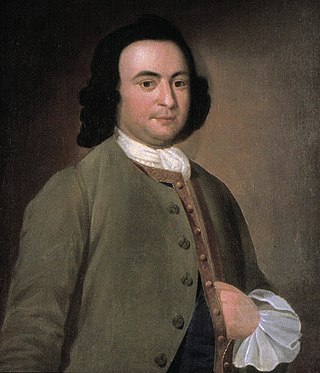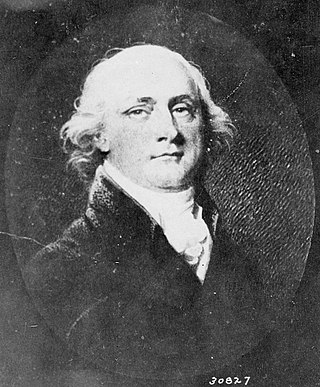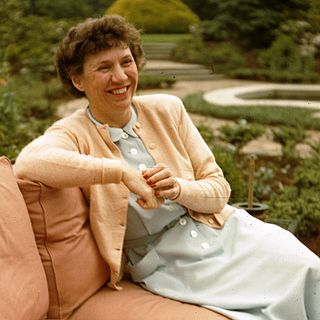
George Mason was an American planter, politician, Founding Father, and delegate to the U.S. Constitutional Convention of 1787, one of the three delegates present who refused to sign the Constitution. His writings, including substantial portions of the Fairfax Resolves of 1774, the Virginia Declaration of Rights of 1776, and his Objections to this Constitution of Government (1787) opposing ratification, have exercised a significant influence on American political thought and events. The Virginia Declaration of Rights, which Mason principally authored, served as a basis for the United States Bill of Rights, of which he has been deemed a father.

Matthew Tilghman was an American planter, and Revolutionary leader from Maryland. He served as a delegate to the Continental Congress from 1774 to 1776, where he signed the 1774 Continental Association.
Colonel Stevens Thomson Mason was an American lawyer, military officer and planter who served in the Continental Army during the Revolutionary War. Mason was also a delegate in the Virginia General Assembly and a Republican U.S. Senator from 1794 to 1803.

James Mercer, was an Virginia lawyer, military officer, planter, jurist and politician.
Captain George Graham, a Virginia planter, lawyer, soldier and politician became an early federal government bureaucrat. He twice served as acting United States Secretary of War, including during the transition between the administrations of Presidents James Madison and James Monroe (1816-1817), as well as Commissioner of the General Land Office (1823-1830) under Presidents John Quincy Adams and Andrew Jackson.

John Francis Mercer was an American lawyer, planter, and politician from Virginia and Maryland, who served as Maryland's governor, as well as terms in the Continental Congress, U.S. House of Representatives, Virginia House of Delegates, and Maryland State Assembly A Founding Father of the United States, he was a delegate to the Philadelphia Convention which wrote the U.S. Constitution.

Gunston Hall is an 18th-century Georgian mansion near the Potomac River in Mason Neck, Virginia, United States. Built between 1755 and 1759 as the main residence and headquarters of a 5,500-acre (22 km2) plantation, the house was the home of the United States Founding Father George Mason. The home is located not far from George Washington's home.

William Buckland (1734–1774) was a British architect who designed several important buildings in colonial Maryland and Virginia.

Lexington was an 18th-century plantation on Mason's Neck in Fairfax County, Virginia, United States. The estate belonged to several generations of the Mason family, and is now part of Mason Neck State Park.
William Mason McCarty was a Virginia lawyer, plantation owner and politician who served in the United States House of Representatives and Virginia Senate, as well as Secretary of the Florida territory and Acting Governor in the absence of Territorial Governor William Pope Duval.
George Mason V was an American planter, businessman, and militia officer. Mason was the eldest son of United States patriot, statesman, and delegate from Virginia to the U.S. Constitutional Convention, George Mason IV and his wife Ann Eilbeck. He received his early education from private tutors at Gunston Hall and was given Lexington plantation on Mason's Neck by his father in 1774. In 1775, he named his plantation to commemorate the Battle of Lexington in Massachusetts.
Thomson Mason was an American lawyer, planter and jurist. A younger brother of George Mason IV, United States patriot, statesman, and delegate from Virginia to the U.S. Constitutional Convention, Thomson Mason would father Stevens Thomson Mason, and was the great-grandfather of Stevens T. Mason, first Governor of Michigan.
Thomson Francis Mason was an American lawyer, planter and politician who served as the mayor of Alexandria between 1827 and 1830, and as a justice of the peace for many years and briefly in the months before his death as a judge of the Washington D.C. criminal court.
William Mason was an American planter and soldier. He was a militiaman in the American Revolutionary War and a prominent Virginia planter. Mason was the third son of George Mason, an American patriot, statesman, and delegate from Virginia to the U.S. Constitutional Convention.
Thomson Mason was an American planter, soldier and politician who represented Fairfax County in both chambers of the Virginia General Assembly. He was one of the sons of George Mason, an American patriot, statesman, and delegate from Virginia to the U.S. Constitutional Convention.
George Mason II (1660–1716) was an early American planter and officeholder who, although his father's only child, had many children and thus can be said to have established the Mason family as one of the First Families of Virginia. His grandson George Mason IV became the most distinguished member of the family, a Founding Father of the United States.

John Mason was an early American merchant, banker, officer, and planter. As a son of George Mason, a Founding Father of the United States, Mason was a scion of the prominent Mason political family.
Mattawoman was an 18th-century plantation on Mattawoman Creek in Charles County, Maryland, United States.
Thomas Mason was an American businessman, planter and politician. As a son of George Mason, a Founding Father of the United States, Mason was a scion of the prominent Mason political family.

Pamela Cunningham Copeland was an American horticulturist and historical preservationist, known for her philanthropy. Her home and gardens became Mt. Cuba Center, a public garden and research center for Appalachian Piedmont flora that was added to the National Register of Historic Places in 2003.













